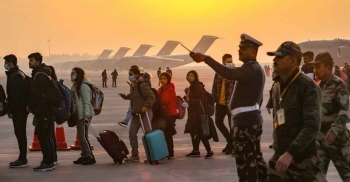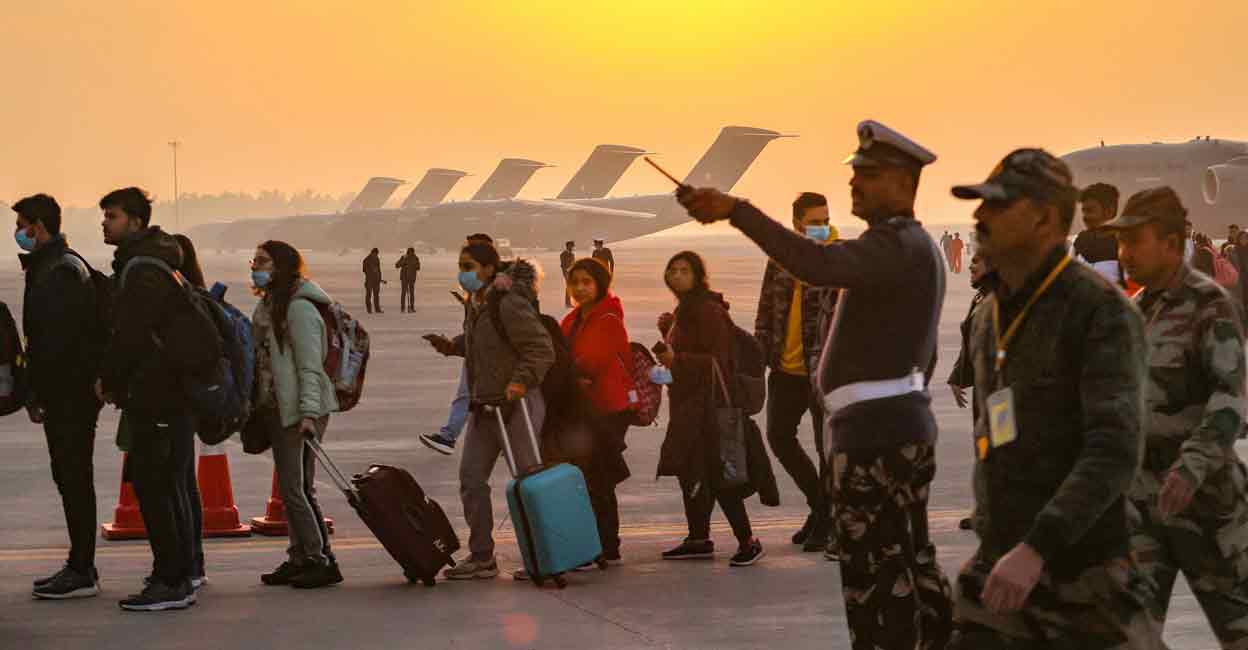
.png) Aarti
Aarti

Much has been written and debated about the Russian military invasion of Ukraine, including the ongoing relentless missile attacks on residential areas in several cities that has left hundreds of civilians dead.
Beyond the massive humanitarian crisis on one side, the cause for concern was the safety of tens of thousands of our students pursuing various courses in that country. But thanks to “Operation Ganga” the herculean evacuation mission initiated by the Central Government on this 26 February, Indian students were first taken in batches from war-torn Ukraine to bordering countries. Subsequently they were all flown to Delhi/Mumbai through special chartered flights.
True, the sudden developments in Ukraine have shattered the dreams of many an Indian student. For a plethora of reasons, many students desire to proceed overseas for higher education. According to official figures, in 2019, about 5.8 lakh students studied abroad. In 2020, it was 2.6 lakh. In so far as Ukraine is concerned, which has about 35 plus medical colleges, around 18,000 Indian students are said to have been enrolled in that country for medical courses. If reports are to be believed, medicine seems to be the leading choice of foreign students in Ukraine. According to a 2019 data, of the 80,470 foreign nationals studying there, 32.3% had joined for degrees in medicine, followed by medical practice with 7.7% and dentistry with 6.3%.
Well, six states with 31% of India’s population account for 58% of the MBBS seats, while eight states which comprise 46% of India’s population have 21% of the MBBS seats. During the last six years, MBBS seats increased by more than 30,000 which is a rise of more than 50% from 2014. The number of PG seats increased by 24,000, which is a rise of over 80% from 2014. In 2014 there were 6 AIIMS in the country, in the last six years, 15 more AIIMS across the country has been approved. Nonetheless, there is acute shortage of health professionals. Official data indicates (as of 2018) there were 11.54 lakh registered allopathic medical doctors, 29.66 lakh nurses and 11.25 lakh pharmacists in India. However, when compared with the norms set by the World Health Organization, the ratio of doctors and nurses to population is quite low. The doctor to population ratio in India is 1:1,511 against the WHO norm of 1:1,000 whereas the nurse to population ratio is 1:670 against the norm of 1:300.
Students, after obtaining foreign MBBS degrees have to qualify in the Foreign Medical Graduate Examination in order to practice in India which is conducted twice a year by the National Board of Examinations. Notably, MCI registration for foreign medical graduates can happen only after passing FMGE. Although the syllabus of FMGE is as per MBBS course, according to reports, in last 12 years, more than 77% of candidates who appeared for FMGE test were unable to pass it. Further, during the last 5 years, FMGE pass rate percentage has dropped to less than 18%. A number of graduates from medical universities in China, Russia, Ukraine, Philippines and other countries are unable to clear FMGE. In 2020, 36,911 candidates appeared and only 5,419 (14.68 per cent) passed the test.
Sadly, enough those who fail to clear FMGE are compelled to take up other professions, that too, after spending time and money in MBBS course abroad. Media reports have time and again highlighted the stark reality. Sample this - a 29-year-old Indian medical graduate from Ukraine who could not clear FMGE shifted to Canada where he is said to run a car washing centre. Another 40-year-old MBBS from Ukraine couldn’t crack FMGE has got into truck business. Similarly, a 32-year-old MBBS graduate from Ukraine couldn’t clear FMGE but under family pressure did an MBA to take charge as “hospital administrator” in the family run hospital. There must be many more who had invested considerable financial resources but could not reap the intended benefits.
One silver lining for the MBBS graduates who have returned from countries like Ukraine is the recent announcement of the Government of India which has permitted the state medical councils to process the applications of Indian medical graduates who have returned with unfinished internships after clearing FMGE. This means hard work is necessary to crack it.
A few years back, the Standing Committee on Health and Family Welfare observed that the present requirements for establishing a medical college are based only on physical space, infrastructure and rigid faculty requirement. The land requirement leads to high initial investment due to which the government and genuine parties (interested in providing medical education) cannot open colleges. The existing minimum standards are causing impediments in the establishment and expansion of medical colleges. It recommended that the requirements for physical infrastructure must be reduced accordingly. Hope policy makers flag this and act,
During a recent webinar on the Union budget announcements for the health sector, Prime Minister Narendra Modi urged private healthcare institutions to enter the sphere of medical education. He said: “today, our children are going to small countries of the world to study, especially for medical education. They are going despite language related problems. Billions of rupees are going out of the country. Can't our private sector come into this field in large numbers? Can't our state governments make good policies so as to allocate land for this type of work so that the maximum number of doctors and paramedics are produced here itself? Moreover, we can meet the demand of the world”. The concerns expressed by the Prime Minister merit consideration.
So, if the private sector has to enter the arena of medical education, there is an imperative need for the norms to set up medical colleges is rationalised in the first place.
In various fora, Dr Devi Shetty, a cardiac surgeon and founder of Narayana Hrudayala group of hospitals, renowned for making heart operations more affordable to many in the country, has been advocating for the need to liberalise medical education. Dr Shetty who carried out the country’s first neonatal cardiac surgery in 1992 and served as the personal physician of Mother Teresa has conducted over 15,000 heart surgeries. Interestingly, he opened a hospital in the Cayman Islands — Health City Cayman Islands. He built it 8 years ago at a cost of $700,000 per bed, versus $2 million per bed in the U.S. Its buildings are said to have large windows to take advantage of natural light and ventilation, saving on air-conditioning costs and open-bay intensive care units, which optimizes physical space and requires fewer nurses to be on duty. If Dr Devi Shetty could achieve this much, it is worth emulation. It ought to be a social commitment rather than a profit motive.
It is another story as far as those students who returned to India from China in the wake of COVID-19 in 2020. Also, it is uncertain when the war would end and those students who have since returned from Ukraine will go back and pursue their courses and complete them. Nonetheless, those in the higher echelons of power need to ensure that medical education in the country is revamped. High fees and less seats in India ought not force students to study in even lesser-known countries.
When India could beat developed countries and consistently continue to hold the position of number one in milk production, why not in medicine.
Efforts in the right earnest can find a way out.